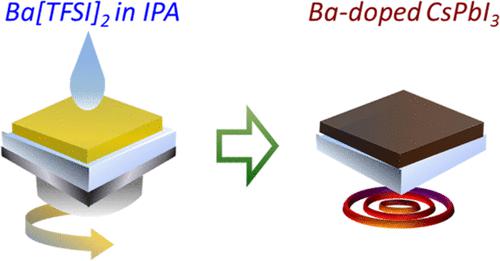当前位置:
X-MOL 学术
›
ACS Appl. Mater. Interfaces
›
论文详情
Our official English website, www.x-mol.net, welcomes your
feedback! (Note: you will need to create a separate account there.)
Phase Stability Improvement of a γ-CsPbI3 Perovskite Solar Cell Utilizing a Barium Bis(trifluoromethanesulfonimide) Solution
ACS Applied Materials & Interfaces ( IF 8.3 ) Pub Date : 2023-10-24 , DOI: 10.1021/acsami.3c10668
Chanyong Lee 1 , Kyungjin Chae 1 , Yohan Ko 2 , Changhyun Lee 1 , Taemin Kim 1 , Seaeun Park 1 , Moo Young Jung 1 , Jinhyoung Kim 1 , Yong Ju Yun 3 , Minoh Lee 1 , Yongseok Jun 1, 3, 4
ACS Applied Materials & Interfaces ( IF 8.3 ) Pub Date : 2023-10-24 , DOI: 10.1021/acsami.3c10668
Chanyong Lee 1 , Kyungjin Chae 1 , Yohan Ko 2 , Changhyun Lee 1 , Taemin Kim 1 , Seaeun Park 1 , Moo Young Jung 1 , Jinhyoung Kim 1 , Yong Ju Yun 3 , Minoh Lee 1 , Yongseok Jun 1, 3, 4
Affiliation

|
The cesium lead iodide (CsPbI3) perovskite solar cell possesses a wide band gap ranging from 1.65 to 1.75 eV, which is suitable for integration into a tandem structure along with a low-band-gap silicon solar cell. Moreover, CsPbI3 has received considerable attention as a potential solution for the prevalent issues of low thermal stability of organic–inorganic perovskite solar cells and phase segregation encountered in conventional mixed halide wide-band-gap perovskite solar cells. Through the implementation of volatile additives, CsPbI3 has demonstrated substantial advancements in efficiency, process temperature, and stability. This study introduces a novel approach for barium (Ba)-doping by spraying an antisolvent containing barium bis(trifluoromethanesulfonimide) during the spin-coating process. By incorporating Ba2+ through this spraying technique, the formation of the delta phase in CsPbI3 is significantly suppressed; thereby, a power conversion efficiency of 18.56% is achieved, and a remarkable 93% of the initial efficiency is maintained after 600 h.
中文翻译:

使用双(三氟甲磺酰亚胺)钡溶液提高 γ-CsPbI3 钙钛矿太阳能电池的相稳定性
碘化铯铅(CsPbI 3)钙钛矿太阳能电池具有1.65至1.75 eV的宽带隙,适合与低带隙硅太阳能电池集成到串联结构中。此外,CsPbI 3作为有机-无机钙钛矿太阳能电池热稳定性低和传统混合卤化物宽带隙钙钛矿太阳能电池中遇到的相分离等普遍问题的潜在解决方案受到了广泛关注。通过使用挥发性添加剂,CsPbI 3在效率、工艺温度和稳定性方面取得了显着进步。本研究介绍了一种新的钡 (Ba) 掺杂方法,即在旋涂过程中喷涂含有双(三氟甲磺酰亚胺)钡的反溶剂。通过这种喷涂技术掺入Ba 2+ ,显着抑制了CsPbI 3中δ相的形成;由此,功率转换效率达到18.56%,并且在600小时后仍保持初始效率的93%。
更新日期:2023-10-24
中文翻译:

使用双(三氟甲磺酰亚胺)钡溶液提高 γ-CsPbI3 钙钛矿太阳能电池的相稳定性
碘化铯铅(CsPbI 3)钙钛矿太阳能电池具有1.65至1.75 eV的宽带隙,适合与低带隙硅太阳能电池集成到串联结构中。此外,CsPbI 3作为有机-无机钙钛矿太阳能电池热稳定性低和传统混合卤化物宽带隙钙钛矿太阳能电池中遇到的相分离等普遍问题的潜在解决方案受到了广泛关注。通过使用挥发性添加剂,CsPbI 3在效率、工艺温度和稳定性方面取得了显着进步。本研究介绍了一种新的钡 (Ba) 掺杂方法,即在旋涂过程中喷涂含有双(三氟甲磺酰亚胺)钡的反溶剂。通过这种喷涂技术掺入Ba 2+ ,显着抑制了CsPbI 3中δ相的形成;由此,功率转换效率达到18.56%,并且在600小时后仍保持初始效率的93%。

































 京公网安备 11010802027423号
京公网安备 11010802027423号